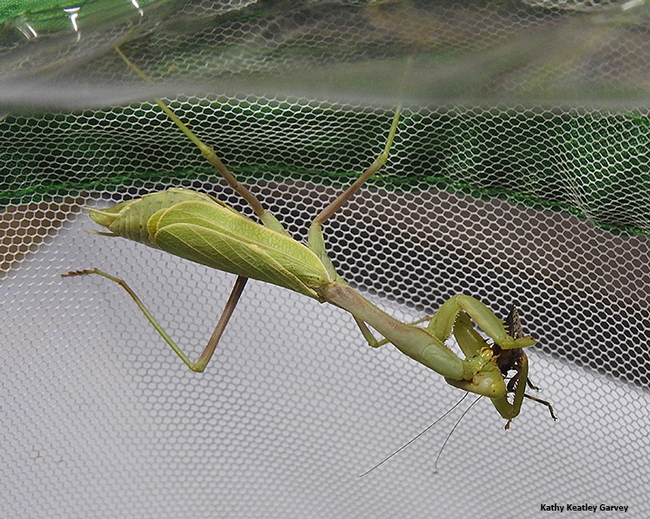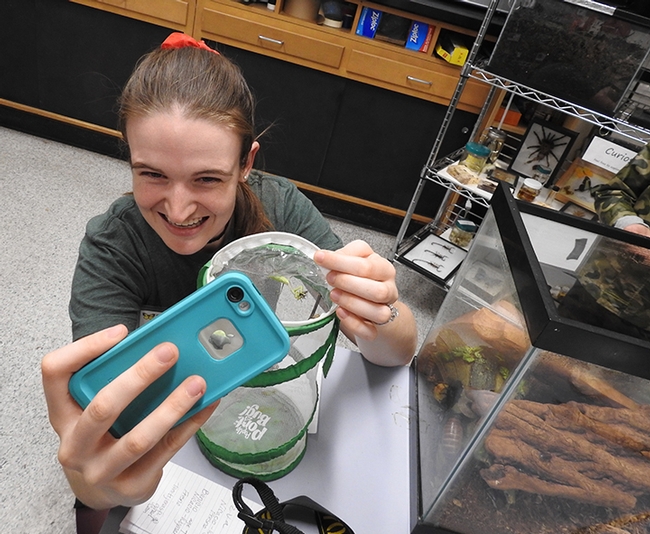- Author: Kathy Keatley Garvey
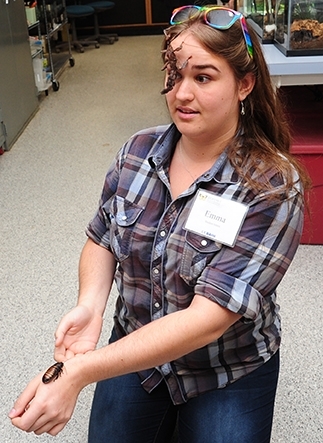
Entomologists from the Bohart Museum of Entomology, UC Davis, will showcase insects, both specimens and live critters, in the Floriculture Building at the 143rd annual Dixon May Fair on Friday, May 11 and Saturday, May 12.
Entomologist Jeff Smith, who curates the butterfly and moth section at the Bohart Museum, will be greeting fairgoers from 2 to 8 p.m., Friday, and displaying collections of bees and butterflies and other specimens, as well as a host of residents from the museum's live "petting zoo."
In addition, Smith plans to bring 10 display drawers that will make you exclaim "Oh, wow!"
And then there are the hissers.
"We had hissing roaches (Madagascar hissing cockroaches) and walking sticks at the Sierra College Science Day on Sunday and, of course, they are a huge hit with kids," Smith said.
Tarantulas also might make a presence.
"We have five tarantulas at the Bohart," said director Lynn Kimsey, professor of entomology at UC Davis. They are Coco McFluffin, Peaches, Princes Herbert, Elsa the Fiesty and ChaCha."
Friday is Kids' Day at the fair when children 12 and under receive free admission all day.
Saturday, May 12
Then on Saturday, May 12, Bohart Museum associate and entomology graduate student Charlotte Herbert (of Princess Herbert fame!) will head the insect museum's tabling activity in the Floriculture Building from 11 a.m. to 1 p.m. She will be joined by Bohart associate and UC Davis student Emma Cluff, and insect enthusiast George Alberts, Herbert's fiance.
The four-day Dixon May Fair opens Thursday, May 10 at 4 p.m. and concludes at 10 p.m. on Mother's Day, Sunday, May 13. Theme of this year's fair is "Home Grown Fun." Also known as the 36th District Agricultural Association Fair, it's located at 655 S. First St.. Hours are from 4 to 10 p.m. on Thursday; noon to 11 p.m. on Friday; 11 a.m. to 11 p.m. on Saturday, and from noon to 10 p.m. on Sunday.
The fair is the oldest district fair and fairgrounds in California, according to chief administrative officer Patricia Conklin. It is linked closely with the communities of Dixon, Vacaville, Fairfield, Rio Vista, Elmira, Woodland and Davis.
The Bohart Museum is a world-renowned insect museum that houses a global collection of nearly eight million specimens. It also maintains a live “petting zoo,” featuring walking sticks, Madagascar hissing cockroaches, tarantulas and praying mantids. A gift shop, open year around, offers T-shirts, sweatshirts, books, jewelry, posters, insect-collecting equipment and insect-themed candy. The Bohart Museum's regular hours are from 9 a.m. to noon and 1 to 5 p.m. Mondays through Thursdays. The museum is closed to the public on Fridays, Saturdays and Sundays and on major holidays. Admission is free. More information on the Bohart Museum is available by contacting (530) 752-0493 or bmuseum@ucdavis.edu. The website is http://bohart.ucdavis.edu/
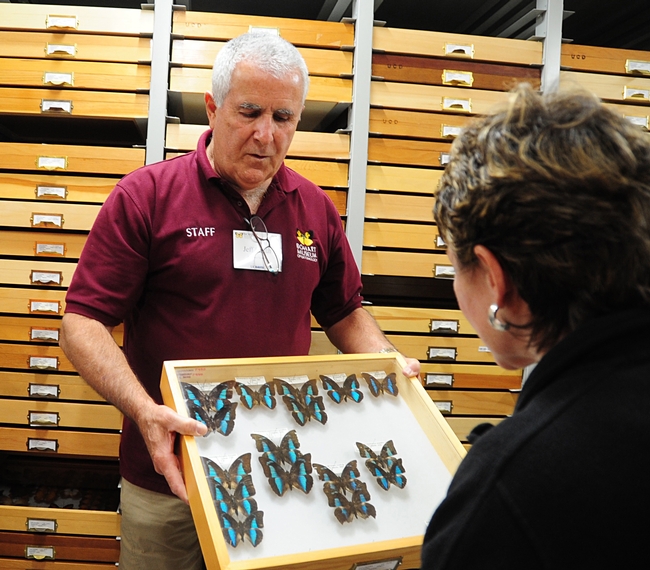
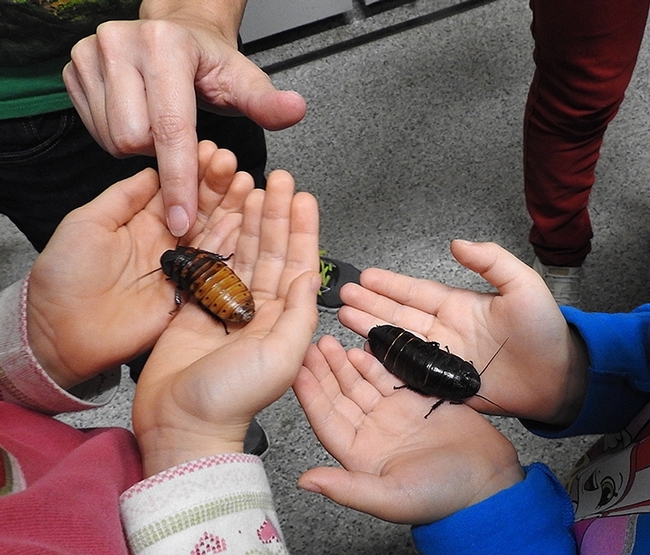
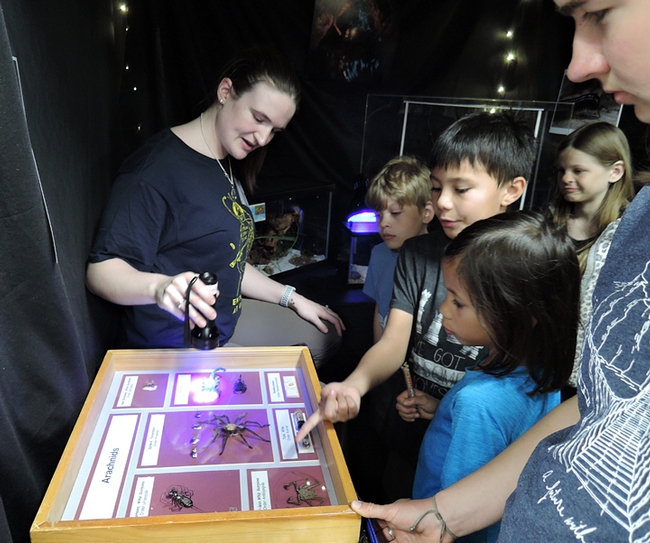
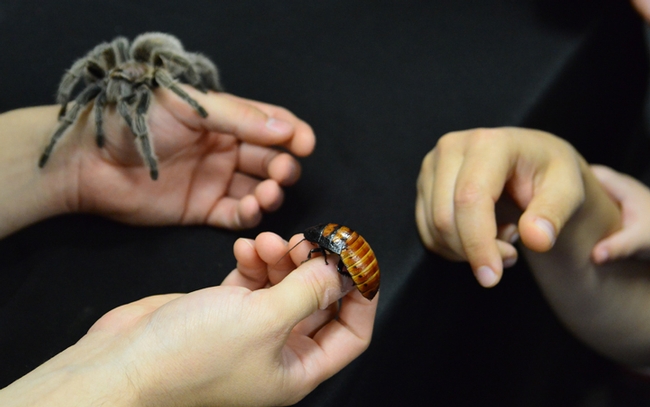
- Author: Kathy Keatley Garvey
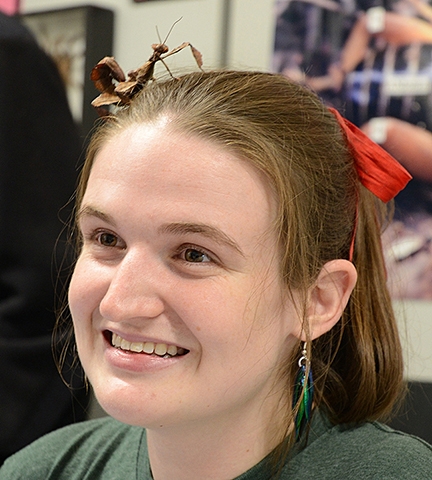
When you attend the UC Davis Bohart Museum of Entomology's open house on Sunday, Jan. 21, featuring insect art, you will find art so intricate and so breathtaking that you may change your career path!
The family friendly event, free and open to the public, takes place from 1 to 4 p.m. in Room 1124 of the Academic Surge Building.
Two of the talented artists showing their work will be Charlotte Herbert, who is seeking her doctorate in entomology from UC Davis, and Ivana Li, a UC Davis biology lab manager who received her bachelor's degree in entomology from UC Davis in 2013.
Herbert studies Asilidae (assassin fly) evolution with major professor Lynn Kimsey, director of the Bohart Museum and professor of entomology. "I hope to someday make my own scientific illustrations for taxonomic revisions," Herbert says. "My dream is to be a curator of an entomology museum." Herbert started drawing and painting in 2015 and "have loved it ever since." She now helps teach Entomology 001, and entomology and art fusion class.
Li, a past president of the UC Davis Entomology Club and a recipient of the UC Davis Department of Entomology's 2012 Outstanding Undergraduate Award, recalls that her fascination with insects began in early childhood but she didn't know the meaning of “entomologist” until her second-grade encounter with Chester. Chester is the main character of George Selden's Newbery-award winning book, A Cricket in Times Square.
"I was pretty thrilled that to find out that there was actually a job in which you get to study insects," Li recalled. "That was the best. It still is.”
The open house, "Bug-Art@The Bohart," will feature a number of artists. UC Davis undergraduate student and artist Karissa Merritt will be on-hand sketching insects for all to see, said Tabatha Yang, education and outreach coordinator. You'll see:
- Art from the collection of the late Mary Foley Bensen, a former Smithsonian Institution scientific illustrator who lived the last years of her life in Davis, and who worked for entomology faculty
- Art from Lynn Kimsey, director of the Bohart Museum and professor of entomology, who illustrated under her maiden name Lynn Siri
- Art by Charlotte Herbert, Ph.D. student; and UC Davis alumni Ivana Li and Nicole Tam, who hold degrees in entomology from UC Davis
- Exhibit of "insect wedding photography" by Bohart associates Greg Kareofelas and Kathy Keatley Garvey
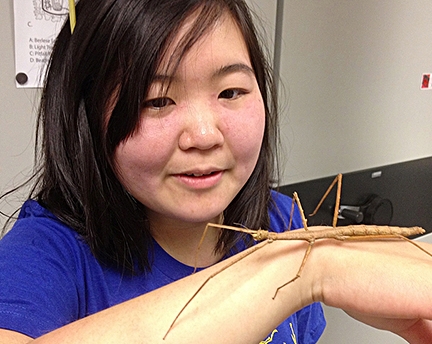
Open house attendees are invited to wear insect-themed attire, including dresses, ties, and jewelry. A contest will take place at 3 p.m. for the best insect-themed outfit, and for the best insect-themed tattoo (tattoo must be in a family friendly location).
Entomologist Jeff Smith, who curates the butterfly and moth collection at the Bohart and is newly returned from a collecting trip to Belize, will be on hand to show the Bohart collection.
In connection with Bohart open house, campus visitors can tour the Design Museum exhibit, It's Bugged: Insects' Role in Design, in 124 Cruess Hall from 2 to 4 p.m. The exhibit, which runs through April 22, includes art from faculty and students affiliated with the UC Davis Department of Design, and specimens from the Bohart Museum, as well as images by UC Davis alumnus and noted insect photographer Alex Wild, curator of entomology at the University of Texas, Austin. Wild received his doctorate in entomology from UC Davis in 2005, studying with major professor Phil Ward.
The Bohart Museum houses a global collection of nearly eight million specimens. It is also the home of the seventh largest insect collection in North America, and the California Insect Survey, a storehouse of the insect biodiversity. Special attractions include a “live” petting zoo, featuring Madagascar hissing cockroaches, walking sticks, praying mantids and tarantulas. Visitors are invited to hold some of the arthropods and photograph them. The museum's gift shop, open year around, includes T-shirts, sweatshirts, books, jewelry, posters, insect-collecting equipment and insect-themed candy.
The Bohart Museum holds special open houses throughout the academic year. Its regular hours are from 9 a.m. to noon and 1 to 5 p.m. Mondays through Thursdays. The museum is closed to the public on Fridays, Saturdays and Sundays and on major holidays. Admission is free. More information on the Bohart Museum is available by contacting (530) 752-0493 or emailing bmuseum@ucdavis.edu or Tabatha Yang at tabyang@ucdavis.edu.
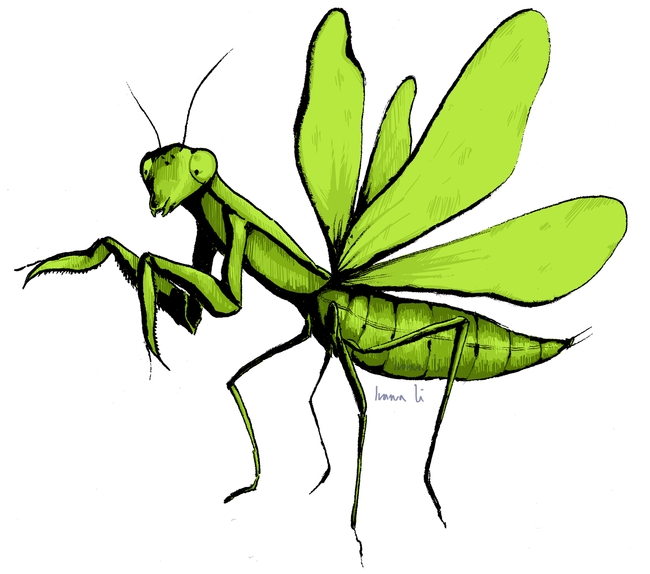
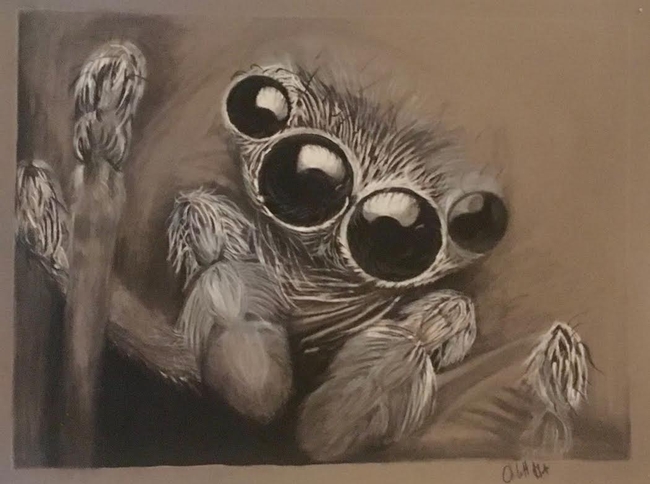
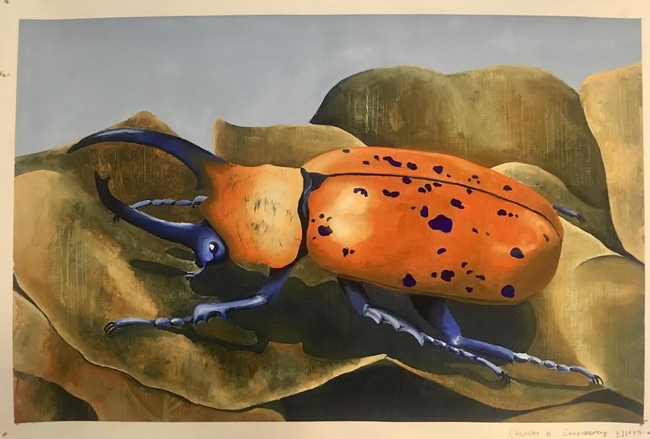
- Author: Kathy Keatley Garvey
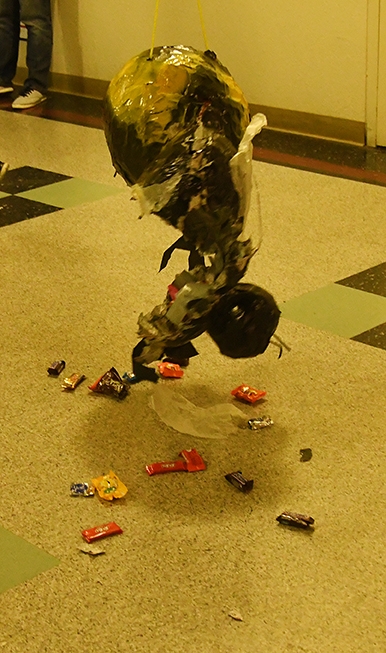
Open to Bohart Museum associates and members of the Bohart Museum Society, the event drew dozens of costumed characters, from honey bees to black widows to a tarantula hawk.
But it was the anatomically correct fly, masquerading as a piñata, that grabbed the most attention. It was the work of UC Davis entomology PhD student Charlotte Herbert; her fiancé, George Alberts; and the Bohart crew.
It was all in keeping with UC Davis alumna Nicole Tam's creative drawing on the party invitation that featured an Acrocera fly, a larva, and a spider. Mama Fly is telling her little one, "You look wonderful, my little larva!" and the little one, in close association with a spider (her food), is responding with: "Thanks, Mom!
Charlotte, who studies Asiloidea phylogenetics with a focus on Asilidae (aka assassin flies) and their predatory lifestyle and venom, came dressed as Maggie the Maggot or an Acroceridae larva, about to pupate and turn into a fly. She added a spider corpse to her costume "as my meal in honor of the party invitation made by Nicole Tam."
A Procyon lotor. A raccoon.
(Editor's Note: More photos of the variety of costumes to follow in Wednesday's blog)
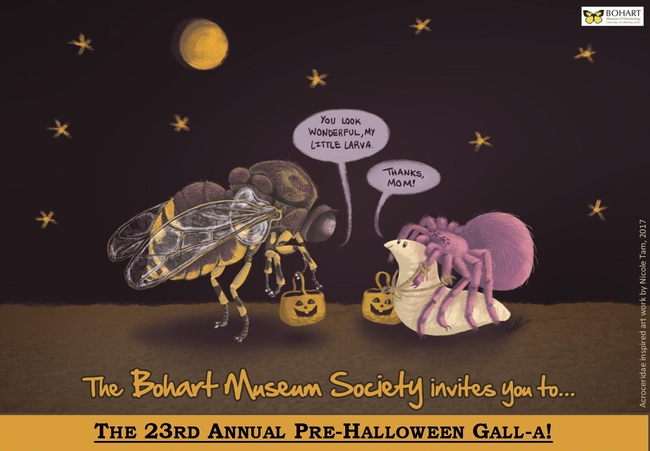
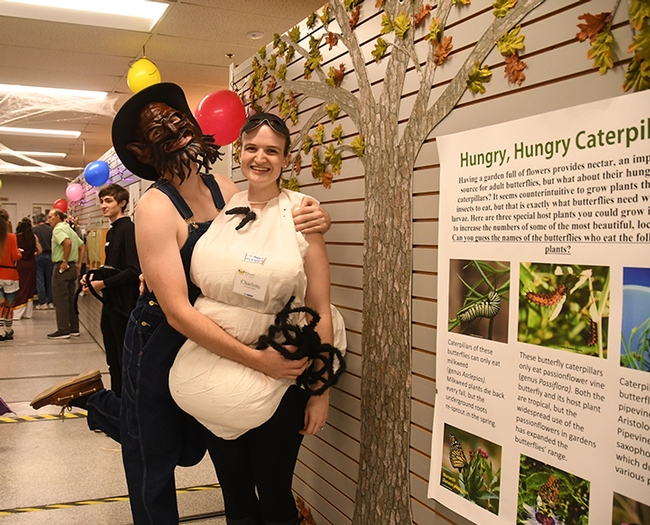
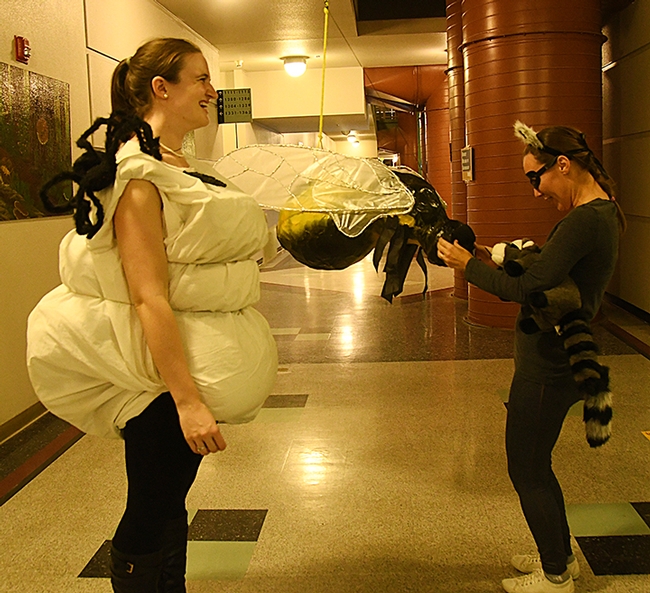
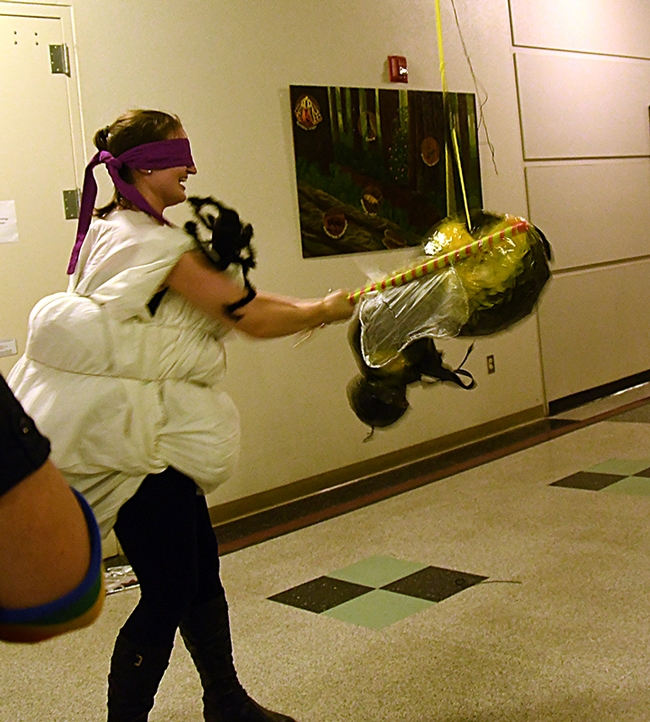
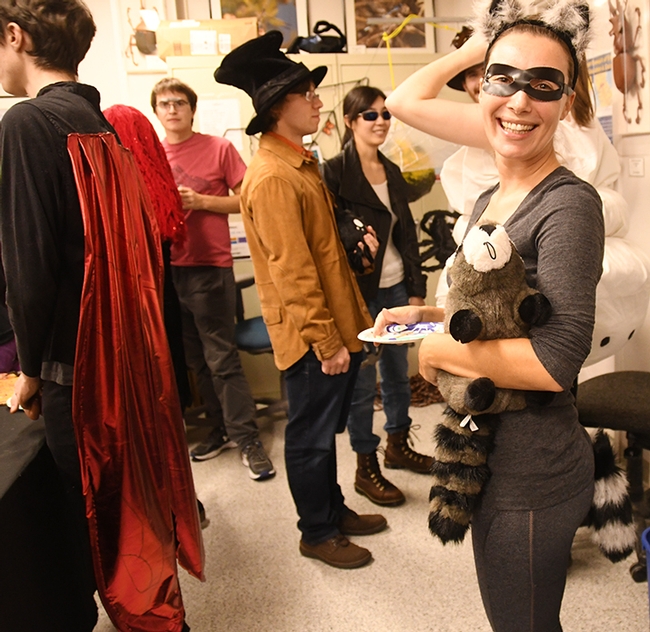
- Author: Kathy Keatley Garvey
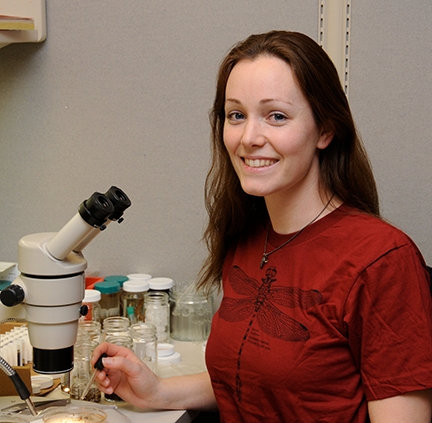
If you're rearing a bed bug colony, they need blood. Yours, if you don't mind.
Someone else's, if there's no one else around.
A big draw at the Bohart Museum of Entomology's recent open house, "Parasite Palooza," was a bed-bug feeding demonstration, featuring bed bugs from a UC Davis-reared colony.
When it was feeding time for the parasitic insects, Cimex lectularius, two scientists stepped forth and offered their arms in the name of science.
Charlotte Herbert, who is studying for her doctorate in entomology, volunteered to be the first "blood donor." Next to step up was nematologist/parasitologist Lauren Camp, who received her doctorate last December at UC Davis.
The particulars: Tabatha Yang, education and outreach coordinator for the Bohart, handed each scientist a bed bug enclosed in fine netting. The netting proved fine enough to prevent escape, but large enough to allow feeding.
"We don't want any escapees," Yang said.
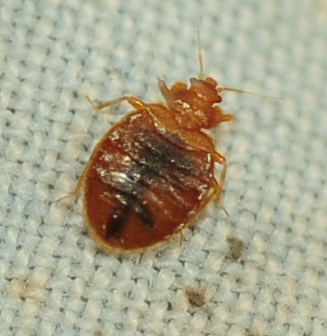
The insects originated from the parent colony of UC Davis entomology graduate Danielle Wishon, now a forensic investigator for the Sacramento Police Department. She began rearing them several years ago, intending to do research. Later she gave some of her bed bugs to UC Davis researcher Jenella Loye of the UC Davis Department of Entomology and Nematology, who in turn loaned some to the Bohart Museum for its "Parasitic Palooza: Botflies, Fleas and Mites, Oh, My."
Wishon says it's fairly easy to rear bed bugs. "If you want a fast growing colony, you can feed them once a week. When I was very actively feeding them, I chose to feed them once or twice a month so the colony didn't get too big too fast. I've gone as much as six months without feeding them, and they repopulated just fine. I started this colony several years back, but I would occasionally add individuals I find on mattresses discarded by UC Davis students during the great fall quarter move."
Wishon acknowledged that in the past, she 'sub-let' feeding responsibilities to forensic entomologist Bob Kimsey of the UC Davis Department of Entomology and Nematology faculty and to entomology student/Bohart associate Wade Spencer. "Hey, they offered!" she said.
Has Wishon ever encountered bed bugs in a hotel room?
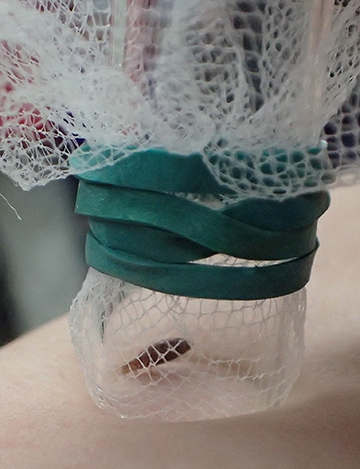
According to the Center for Disease Control and Prevention (CDC): "Everyone is at risk for getting bed bugs when visiting an infected area. However, anyone who travels frequently and shares living and sleeping quarters where other people have previously slept has a higher risk of being bitten and or spreading a bed bug infestation."
"Bed bug infestations usually occur around or near the areas where people sleep," the CDC points out on its website. "These areas include apartments, shelters, rooming houses, hotels, cruise ships, buses, trains, and dorm rooms. They hide during the day in places such as seams of mattresses, box springs, bed frames, headboards, dresser tables, inside cracks or crevices, behind wallpaper, or any other clutter or objects around a bed. Bed bugs have been shown to be able to travel over 100 feet in a night but tend to live within 8 feet of where people sleep."
Bed bugs are not known to spread disease, according to the CDC. However, excessive scratching can "sometimes increase the chance of a secondary skin infection."
Wishon noted that some people experience a "pretty negative reaction to the saliva--flu-like symptoms if I remember correctly. That's really the reason I want to keep feeding a colony even though I am not going to be doing research on them anytime soon--most of the older researchers I know who once fed a colony but stopped, or who traveled to countries where they were common and were exposed regularly but then moved back, and were exposed to them many years later, seem to develop hyper sensitivity to bed bug saliva. This could be completely anecdotal and coincidental, but I've heard this familiar story enough times to want to error on the side of caution and continue feeding without years of breaking. I don't want to develop a negative reaction to exposure."
Both Camp and Herbert said they basically didn't feel much of anything when the bed bugs began feeding. Here's why: "When bed bugs bite, they inject an anesthetic and an anticoagulant that prevents a person from realizing they are being bitten," according to the CDC. "Most people do not realize they have been bitten until bite marks appear anywhere from one to several days after the initial bite. The bite marks are similar to that of a mosquito or a flea -- a slightly swollen and red area that may itch and be irritating. The bite marks may be random or appear in a straight line. Other symptoms of bed bug bites include insomnia, anxiety, and skin problems that arise from profuse scratching of the bites."
Any reactions? "It took a while, but I did react to the bed bug bites," Camp said. "On the third day (Jan. 25), I saw raised red marks on my right arm, that were a bit itchy. Guess it took me three days to react."
Said Herbert: "I had a very small red mark where it bit, but no lasting marks or feelings. I felt it bite, but just barely. However, I have had bed bugs before while visiting my grandparents in the U.S. Virgin Islands and the bites were pretty terrible! I was itchy and thrashed all night, I didn't realize what was happening until the morning when I was covered in little bite marks and we found the bed bugs on the edges of the mattress. They looked very well fed!
No wonder folks say: "Good night! Sleep tight! And don't let the bed bugs bite."

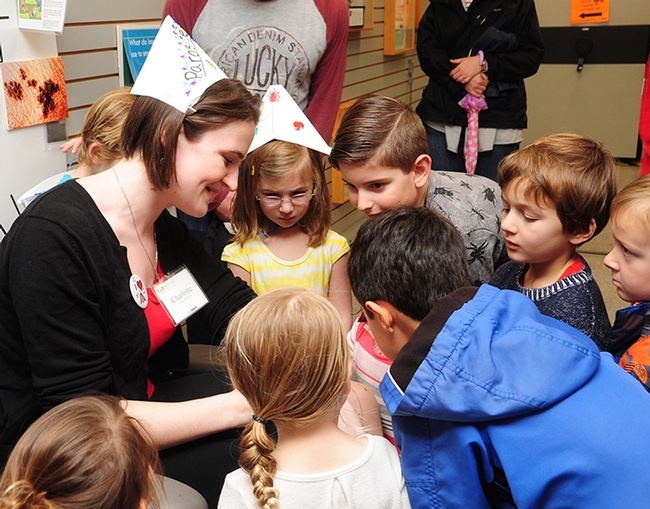
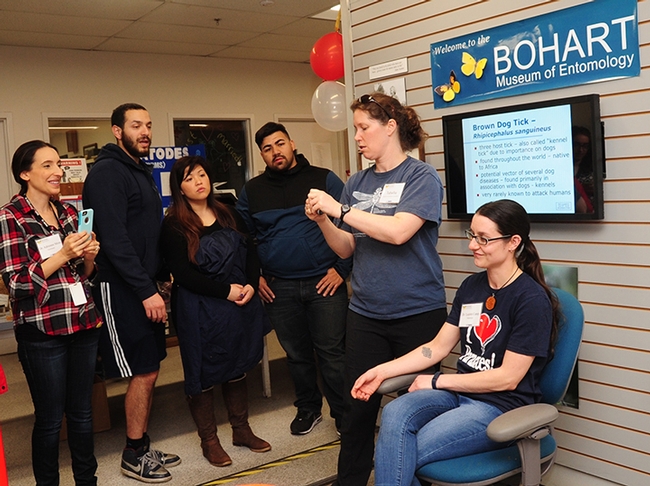
- Author: Kathy Keatley Garvey
Oh, if we could just engage in some menu planning and preparation!
How often have you thought of that after watching praying mantids dine on honey bees, bumble bees, monarchs, Western tiger swallowtails and other beneficial insects?
"Please don't eat the pollinators!" I plead, tongue in cheek. "Why not grab a tasty stink bug?"
Well, last Saturday afternoon, Nov. 19 at the Bohart Museum of Entomology, UC Davis, that's exactly what a mantid did. It nailed a stink bug, held it between its spiked forelegs and ate it, not unlike an Thanksgiving-Day interaction between a two-legged human being and a turkey drumstick.
UC Davis entomology graduate student Charlotte Herbert happened by and took a selfie. Serendipity: one of her class assignments was to take a selfie with an insect.
No doubt she was the only one in her class who took a selfie with a praying mantis eating a stink bug!
The occasion: a Bohart open house themed "Uninvited Guests: Common Pests Found in the Home."
The Bohart Museum, home of a global collection of nearly eight million insect specimens (plua a live "petting zoo" and a gift shop) is now gearing up for its next open house, "Parasite Palooza: Botflies, Fleas and Mites, Oh My!" set from 1 to 4 p.m., Sunday, Jan. 22 in Room 1124 of the Academic Surge Building, Crocker Lane. The open houses are free and open to the public. See schedule.
The Bohart Museum's regular hours are from 9 a.m. to noon and 1 to 5 p.m. Mondays through Thursdays. The museum is closed to the public on Fridays, Saturdays and Sundays and on major holidays. Admission is free. More information on the Bohart Museum is available by contacting (530) 752-0493 or bmuseum@ucdavis.edu.
